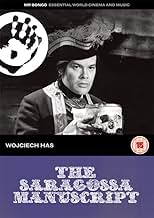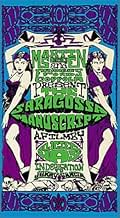IMDb RATING
7.7/10
6.3K
YOUR RATING
Upon finding a book that relates his grandfather's story, an officer ventures through Spain meeting a wide array of characters, most of whom have a story of their own to tell.Upon finding a book that relates his grandfather's story, an officer ventures through Spain meeting a wide array of characters, most of whom have a story of their own to tell.Upon finding a book that relates his grandfather's story, an officer ventures through Spain meeting a wide array of characters, most of whom have a story of their own to tell.
- Director
- Writers
- Stars
- Awards
- 1 win total
- Director
- Writers
- All cast & crew
- Production, box office & more at IMDbPro
Featured reviews
10Levana
"The Saragossa Manuscript" is a brilliant work, by turns (or simultaneously) mysteriously spooky and wildly funny. Its unusually long running time does not get tiring because it is so full of variety and unfailing inventiveness. The stories of a crowd of distinctive characters intermesh into a unity that is not obvious at first, but slowly grows clearer -- one of the ideas that can be gathered from the movie is precisely that of the interdependence of people who would seem to have little in common, whether Christian, Jew or Moslem. It's a profoundly humanistic idea.
This theme is the contribution of the novelist Jan Potocki, a Pole living in France when he wrote "The Manuscript Found in Saragossa" at the beginning of the 19th century. One of the main strengths of the movie is also mainly Potocki's, the creation of a Spain of dreams, full of romance, mystery, lively humor, and eroticism (the novel found difficulty in being published originally, and the author was criticised for his libertinism). As vividly brought to the screen by Wojcech Has, this Spain is a place that a viewer will want to return to repeatedly.
Has, however, strongly emphasized the phantasmagorical elements in the novel. The atmosphere that he creates, and the visual style that supports it, are another major asset of the movie. The images of the haunted Sierra Morena are consistently touched with strangeness but not overburdened. I think especially of one shot where the tumbled white rocks look just like bleached bones -- an effect that wouldn't have worked so well if the movie had been in color. In keeping with this shift of emphasis, the adaptation contributes a new ending to the story, which is entirely appropriate; it comes from a distinctly twentieth-century sensibility.
Add to this a uniformly skillful cast (special recognition goes to Slawomir Lindner as the elder Van Worden) and you have a movie that I can't recommend strongly enough.
This theme is the contribution of the novelist Jan Potocki, a Pole living in France when he wrote "The Manuscript Found in Saragossa" at the beginning of the 19th century. One of the main strengths of the movie is also mainly Potocki's, the creation of a Spain of dreams, full of romance, mystery, lively humor, and eroticism (the novel found difficulty in being published originally, and the author was criticised for his libertinism). As vividly brought to the screen by Wojcech Has, this Spain is a place that a viewer will want to return to repeatedly.
Has, however, strongly emphasized the phantasmagorical elements in the novel. The atmosphere that he creates, and the visual style that supports it, are another major asset of the movie. The images of the haunted Sierra Morena are consistently touched with strangeness but not overburdened. I think especially of one shot where the tumbled white rocks look just like bleached bones -- an effect that wouldn't have worked so well if the movie had been in color. In keeping with this shift of emphasis, the adaptation contributes a new ending to the story, which is entirely appropriate; it comes from a distinctly twentieth-century sensibility.
Add to this a uniformly skillful cast (special recognition goes to Slawomir Lindner as the elder Van Worden) and you have a movie that I can't recommend strongly enough.
Oh boy. I first saw this about thirty years ago, and have caught it twice since. Other than a slight reservation concerning its length, I find it a delight, and would love to see it again. In form, it resembles the Gothic novel that was popular at the turn of the 19th century, with its nested plots and bizarre ambiances and characters. The novel on which it's based was recently published in an English translation, and proves to be a delight as well--literate, witty, and dizzying. The photography and design of this film are breathtaking, and I think it's definitely worth a viewing, if, as, and when it comes around. I advise strongly against looking for Inner Meaning. It's kind of like seeing an exhibition of Magritte paintings; sometimes a flaming tuba is just a flaming tuba.
The comments on this film seem evenly distributed between favor and disfavor. At this date, I can't understand why anyone would not like it, but that's me. I first saw it in 1967, while I was in college. I loved it, and went so far as to locate and purchase the book(s) from which it was adapted. And that was before the internet, and Amazon, and Bookfinder. One of the books I didn't manage to get until I got to London. Reading it, I was amazed to realize that the film actually includes remnants of every story in the book(s): when, for example, Alphonso opens a door to find a bewigged scholar interrupted while declaiming "...Then the first skeleton tore out his own arm-bone and began hitting me with it..."-the whole story is there in the book, i.e., what the skeletons were doing there in the first place. The books, Manuscript Found At Saragossa and the New Decameron, are rightly considered Literary Treasures of Poland, along the lines of Notre-Dame á Paris in France, War and Peace in Russia, or Moby-Dick here. It's about stories and storytelling.
By the end of the film, to say the least, the viewer has been presented with a convincing picture of sixteenth-century Europe from different angles, and it's safe to say that no other film, before or since, in color or Black-and-white, has done it better.
By the end of the film, to say the least, the viewer has been presented with a convincing picture of sixteenth-century Europe from different angles, and it's safe to say that no other film, before or since, in color or Black-and-white, has done it better.
10co_iww
Before I start gushing about this film, keep in mind that I rarely see European (let alone Polish) films, and I rarely see "vintage" films. The few "art houses" in Denver typically show films, like Crouching Tiger, which are intended for US audiences and distributed to regular first-run theaters in most major cities. Since I don't study the listings religiously, nor do I always have 10 bucks to blow on a film, I rarely encounter films that challenge the norms of either mainstream Hollywood or the recent Hollywood-controlled "indie" film industry. Needless to say, this film floored me. I was immediately amazed by the vividness of its black-and-white imagery. While b/w has become an overused technique to depict bleakness, this film reminded me just how little all the high-tech Hollywood production methods actually use the medium of film itself to its fully expressive potential. This film is visually stunning in its images' depth, textures, and light. The next thing that struck me was how outrageously funny the film is--funnier than I could have imagined a 40 year-old movie from a culture about which I know almost knowing. Three hours later, I didn't want the film to end. Its cycles of absurd story lines, surreal dialog, and engaging imagery were utterly new and engrossing to me. Despite my Luddite tendencies, I have vowed that when this film is released on DVD, I'll go out and get a player just to see this film over and over again. Perhaps then I'll have more critical comments--for now, just WOW.
i have a really low threshold for boredom, and while i saw this on the bigscreen, in a real theatre, i was spellbound. i didnt know what to expect, but it was mesmerising. i didnt try intellectualise it, but it was impossible to pick apart. just see it. put your head into the time period that the story is trying to convey. caveat: i think apocalypse now is an amazing film. redux was great. when i walked out of the theatre after seeing saragossa, i couldnt speak for hours. do yourself a favor and at least give this one a shot. try and see it on the big screen if you can.
Did you know
- TriviaLuis Buñuel, who seldom viewed movies more than once, liked this film so much that he saw it three times.
- Quotes
Donna Rebecca Uzeda: All these adventures begin simply. The listener thinks it'll soon be over, but one story creates another, and then another.
Don Pedro Velasquez: Something like quotients which can be divided infinitely.
- Alternate versionsOriginally released in a cut version in the US, the film was restored to it's original 182-minutes running time and premiered at the New York Film Festival in September 1997. The restoration project, supervised by Edith Kramer, was initially sponsored by Grateful Dead's leader Jerry Garcia and later completed by Francis Ford Coppola and Martin Scorsese. The restored version includes a dedication to Jerry Garcia.
- ConnectionsFeatured in Aktorka (2015)
- How long is The Saragossa Manuscript?Powered by Alexa
Details
- Release date
- Country of origin
- Official site
- Language
- Also known as
- The Saragossa Manuscript
- Filming locations
- Olsztyn, Slaskie, Poland(castle)
- Production company
- See more company credits at IMDbPro
Box office
- Gross worldwide
- $13,377
- Runtime3 hours 2 minutes
- Color
- Sound mix
- Aspect ratio
- 2.35 : 1
Contribute to this page
Suggest an edit or add missing content


































